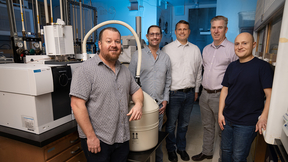LLNL delivers eight Scorpius pulsed-power modules to Los Alamos
Lawrence Livermore National Laboratory (LLNL) recently delivered eight prototype pulsed-power modules for testing to Los Alamos National Laboratory (LANL), marking completion of a key milestone in a multi-lab effort to develop Scorpius, a next-generation particle accelerator for X-ray imaging.
The line replaceable units (LRU) will provide the precise energy pulses needed to accelerate particle beams and ultimately capture multiple X-ray images of dynamic experiments on nuclear weapon components.
These images will enable LLNL and other national security laboratories to certify the safety, security and effectiveness of modernized nuclear warheads without resorting to full-scale nuclear testing.
Juliana Hsu, program manager for the W87-1 program at LLNL, said the data provided from Scorpius will support the assessment of the nuclear deterrent.
“In the process of modernizing the warheads we need data to support that assessment and certification,” Hsu said. “The radiography capability with real material in plutonium is very crucial in supporting such an endeavor.”
Al Churby, senior team lead of the project at LLNL, said there is great collaboration between the individual sites. Sandia National Laboratories is creating the injector, Los Alamos is developing the accelerator cell, LLNL is focusing on the pulsed power and the Nevada National Security Site (NNSS) is focusing on building and commissioning the machine, which will be fielded within U1a at NNSS. Once deployed at NNSS, Scorpius will generate four high-fidelity radiographic images of contained subcritical experiments utilizing special nuclear material.
“One of the drivers that is producing great collaboration is that the mission need is singular. It's to aid stockpile stewardship, which the complex as a whole needs and is a critical part of,” Churby said. “This particular project is taking the skill set of each individual lab and pulling those individual strengths together to create a holistic solution to a very complex problem.”
The accelerator will be comprised of 984 LRUs. Inside each pulser, there are 45 printed circuit boards totaling more than 3.5 million electrical components in the pulsed power system. The pulsers are designed to make four 25,000-volt pulses, which will energize a 22.4 MeV injected electron beam. That beam will then collide with a metal target, generating X-rays capable of penetrating experimental test objects and recording required images.
“Building the pulsers is quite the undertaking,” said Jared Tippens, LLNL mechanical engineer, adding that the team is always trying to improve things by saving space in the pulsers and there is a huge incentive to keep optimizing the footprint of the pulsers.
As the design and testing process culminates in the final design, LLNL will deliver nearly 1,000 pulsers required for the Scorpius installation.
“The mission is super important and the capability that we are going to be providing will be around for multiple decades,” Churby said.
Contact
 Michael Padilla
Michael Padilla
[email protected]
(925) 341-8692
Related Links
Los Alamos National LaboratorySandia National Laboratories
Nevada National Security Site
Tags
Strategic DeterrenceFeatured Articles







